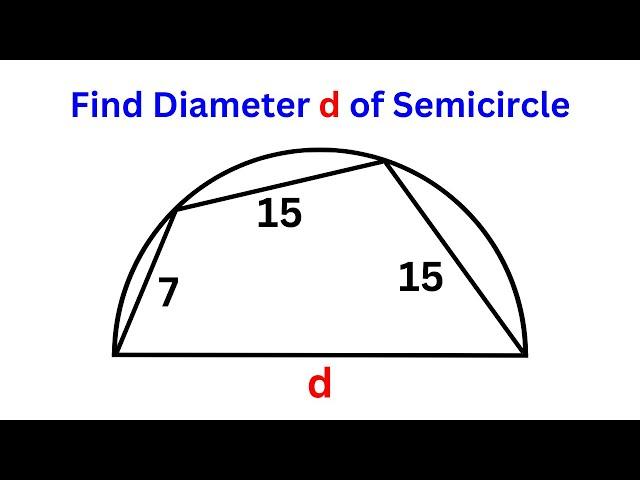
Philippines Maths Olympiad 2020 Problem | Geometry | Important Geometry Skills Explained
Комментарии:

Teşekkürler.
Ответить
Very nice solution
Ответить
There was once a very similar problem. First year of USAMTS (1989-1990), round 4, question 1:
A hexagon is inscribed in a circle of radius r. Find r if two sides of the hexagon are 7 units long, while the other four sides are 20 units long.

7
Ответить
I do not have a good English.
Let be x and y the diagonals of the cyclic quadrilateral. So:
d^2-49=x^2
d^2-225=y^2.
But as the quadrilateral is cyclic xy=15*(7+d) ...(xy)^2=15^2*(d+7)^2
(d^2-49)*(d^2-225)=15^2*(d+7)^2
(d-7)*(d^2-225)=225*(d+7)
d^3-7d^2-450d=0 as d<>0
d^2-7d-450=0 d=25 or d=-18(not good)
So d=25.

Great
Ответить
Here a short solution based on the known trigonometric identity cos(2x) = 1 - 2 * sin(x)^2:
We can extract the following 3 equations from the task:
sin(a) = 7/d
sin(b) = 15/d
a + 2*b = pi/2 (note: both a and b are the half angles, so a + 2b sums up to 90° = pi/2)
Using those and the above identity we get sin(a) = sin(pi/2 - 2*b) = cos(2*b) = 1 - 2 * sin(b)^2, and therefor 7/d = 1 - 2 * (15/d)^2, which can be reshaped to:
d^2 - 7d - 450 = 0.
Solving this quadratic equation we find: d = (7 +/- 43)/2, and the only positive solution is therefor d = 25.

Solution without angles. Use "diagonals product" (e*f) theorem for cyclic quadrilaterals:
e*f = a*c + b*d
e*f = 15*2r + 7*15
Combine with two right triangle equations having 2r as their hypoteneuse:
e^2 = (2r)^2 - 15^2
f^2 = (2r)^2 - 7^2
Using some algebra, a quartic equation in r was developed, and solved using an online solver. r = 12.5. If Math Olympiad doesn't allow computational tools, it's growing obsolete as a forum for advanced problem-solving.

Brute force approach: Note that AO, BO, CO and DO are radii, call their length R. Drop perpendiculars from O to AD, call the intersection E, O to CD, call the intersection F, and O to BC, call the intersection G. Note that ΔOBG, ΔOCG, ΔOCF, and ΔODF are congruent. <BOG = <COG = <COF = <DOF. Also, ΔODE and OAE are congruent. <AOE = <DOE The sum of all 6 angles is 180°. Note that <AOE = arcsin(3.5/R) and <DOF = arcsin(7.5/R). So, 2arcsin(3.5/R)+4arcsin(7.5/R)=180° or arcsin(3.5/R)+2arcsin(7.5/R)=90°. Replace the 90° by x and, by trying values of R, attempt to find the value of R which results in x being 90°. Let's start with R=10 and get x=117°. We know that we need to increase R to reduce the value of x, so try R=11 and x= 104.5°. Try R=12 and x=94.3°. Try R=13 and x=86°. We now know that R=13 is too high and R=12 is too low, so try R=12.5 and, as luck would have it, x=90.000000000° on my scientific calculator. So, R=12.5 and the diameter is 25.
Ответить
my answer is 25 .2 simply using cosine law. 3 angles along the dia. are 34/73/73 degree. anyone agrees? why it diff. with yours (25)?
Ответить
I like to solve everything with trigonometry. Obviously 7/(2*sin(x/2)) = 15/(2*sin((Pi-x)/4)) => sin(x/4) = √2/10 and sin(x/2) = 7/25 => d = 2* (7/(2*7/25)) = 25.
Ответить
تمرين جميل جيد . رسم واضح مرتب . شرح واضح مرتب . شكرا جزيلا لكم والله يحفظكم ويرعاكم ويحميكم جميعا . تحياتنا لكم من غزة فلسطين .
Ответить
Look for triplets and this gives d = 25 also ptoelmy's theorem is satisfied with this...
Ответить
I used Ptolemy's theorem to arrive at d³ – 499d – 3150 = 0
Solving gives d = -18, -7 and 25, so d = 25 as the other 2 options are -ve.

BD = x, AC = y, x*2 + 49 = d*2, y*2 + 225 = d*2, (Ptolemy's theorem) 15d + 105 = xy, (d*2 - 49)(d*2 -225) = (15d + 105)*2 (d > 0), solving by the usual algebra methods, d = 25.
Ответить
What this video lacks is a description of a plan to find the solution.
Ответить
O be the centre of this semi circle
Join radii OB, OC, OD.
In quadrilateral OBCD
DC = BC & OD = OB
Hereby quadrilateral OBCD is a kite
Its duagonal CO perpendicularly bisects BD at P.
Again ∆ DAB is similar to ∆ POB
PO / AD = BO/ AB = 1/2
PO = AD/2 and CP = r - AD/2
Again
BO^2 - OP^2 =BP^2 =BC^2 -CP^2
BC^2 - r^2 = CP^2 - OP^2
= ( CP + OP) (CP - OP)
= r ( r - OP - OP)
= r ( r - AD)
Hereby 2 r ^2 - r AD = BC^2
Herein. 2 r ^2 - 7 r - 225 = 0
2 r^2 - 25 r + 18 r -225 = 0
(2 r - 25)( r + 9) = 0
Duameter of semi circle
2 r = 25

Assuming that the drawing is in scale, I measure length "d" with a school ruler, then I calculate the proportion according to the scale, and it gives me approximately 25 cm
d = 25 cm (Solved √ )

Cosine theorem:
7² = R² + R² - 2R² cos α
7² = 2R² - 2R² cos α
7² = 2R² (1 - cos α)
Cosine theorem:
15² = R² + R² - 2R² cos β
15² = 2R² - 2R² cos β
15² = 2R² (1 - cos β)
Supplementary angles:
180° = α + 2 β
Put these formulas in an Excel worksheet and will obtain :
R = 12,5 cm
D = 25 cm. (Solved √ )

Taking the appropriate right triangle:
D² = (2.R)² = 7² + C²
C² = 4R² - 7²
C²/4 = R² - 7²/4
(C/2)² = R² - 3,5²
Taking the other appropriate right triangle:
(C/2)² + (R-3,5)² = 15²
(C/2)² = 15² - (R-3,5)²
Equalling :
R² - 3,5² = 15² - (R-3,5)²
R² - 3,5² = 15² - ( R² - 7R + 3,5²)
R² - 3,5² = 15² - R² + 7R - 3,5²
2 R² - 7R - 15² = 0
R² - 3,5 R - 112 ,5 = 0
R = 12,5 cm
D = 25 cm. ( Solved √ )

sin(BDA) = sin(φ) = 1 → AB = 25 → ∆ABD = pyth. triple (7-24-25)
Ответить
Beautiful problem. Thank you Sir.
Ответить
Merci
Ответить
Problem can be made MUCH SIMPLER if you first re-arrange the 3 lines, putting the 7 one between the two 15 long ones, without changing the problem. That makes construction symmetrical about vertical line through circle center (bisects the 7 line), & the 7 line is parallel to the bottom diameter line. This vertical line (center to intersection of the 7 long line) is part of right triangle hypotenuse is R, short leg is 7/2 (because of symmetry). This line's length squared is = R^2 - (7.2)^2.
There is another right triangle formed: hypotenuse 15, short leg R - (7/2), & long leg same as other triangle, R^2 - (7.2)^2. Applying poth theorem to this triangle gives equation 2R^2 - 7R -225 = 0. Solution to this is R = 12.5 (neg solution rejected), giving D = 25.

Gostei da solução
Ответить
DC = BC results in
angle DOC = angle BOC
Hereby ∆ DOE & ∆ BOE congruent
angle DEO = angle BEO = π/2

Very easy if cosine law is applied along the centre. No need for such complicated solution.
Ответить
Looking into the reasons why my previous solution was wrong, I found this other solution:
We trace the radii that join the center of the semicircle with the extremes of the three chords and also those perpendicular to them. We obtain 4 congruent triangles whose side measures 15/2 and 2 congruent triangles whose side measures 7/2. Using a little trigonometry we can write
15/2 = r*sinx
7/2 = r*siny
now we know that
4x + 2y = 180° then
y = 90° - 2x
for which
7/2 = r*sin(90° - 2x)
using the formulas of the associated arcs
sin(90° - 2x)=cos2x and cos2x = 1 - 2sin²x
then we solve the system of equations by treating sinx as one of the unknowns (r,sinx)
15/2=r*sinx
7/2=r*(1-2sin²x) that gives
2r²-7r-255=0 that gives r=25/2

OE is connecting middles of sides to triangle DAB,so OE = DA/2 = 7/2. OC=r and CE=CO-EO= r - (7/2).
COMPLETE CIRCLE and CO intercepts in point F, so FE= r +(7/2) . Aplying Intercepting Chords Theorem into point E for chords DB and CF, we have DE*EB = CE*EF so since DE=EB DE^2 = CE*EF so DE^2 = ( r - (7/2) )*( r +( 7/2) ) (1)
Also from PYTH.THEOR to DEC right triangle DE^2=15^2- ( r - (7/2))^2 (2)
From equalities (1),(2) we have ( r - (7/2) )*( r +( 7/2) ) = 15^2- ( r - (7/2))^2 so r^2 -(49/4) = 225 - ( r - (7/2))^2 AND 4*r^2 - 49 = 900 - 4 r ^2 +28*r - 49 so 8*r^2 - 28*r - 900 = 0 .
(Dividing by 4) 2*r^2 - 7*r - 225 = 0 . D=49+1800=1849 = 43^2 . Hence r1= (7+43) /4 = 50/4 = 25/2 ACCEPT and r2=(7 - 43)/4 = - 9 REJECT. Finally d= 2*r = 2* 25/2 = 25.

Join the diagonals AC and BD.
Now apply Ptolemy's Theorem to cyclic quadrilateral ABCD
15d + 15 X 7 = V(d^2 - 15^2) X V(d^2 - 7^2)
Square both sides
225(d+7)^2 = (d^2-225)(d+7)(d-7)
Divide both sides by (d+7)
(d^2-225)(d-7) = 225(d+7)
d^3 - 7d^2 - 225d + 225 X 7 = 225d + 225 X7
d^3 - 7d^2 - 450d = 0
Divide by d
d^2 - 7d - 450 =0
(d+18)(d - 25) = 0
d cannot be -18 and so d= 25
Sumith Peiris
Moratuwa
Sri Lanka

Wow, neat solution. Here is how I did it, which is so totally different:
Let AD = d
Join A and C.
Since BD = CD = 15, then angles subtended by arcs BC and CD will be equal.
Therefore, ∠BAC = ∠CAD = θ, and ∠BAD = 2θ
Since AB is a diameter, then △ABC has right angle at C and
sin θ = sin(∠BAC) = BC/AB = 15/d
Join B and D to form △ABD.
Since AB is a diameter, then △ABD has right angle at D and
cos(∠BAD) = AD/AB = 7/d
But we can also calculate as follows:
cos(∠BAD) = cos 2θ = 1 − 2sin²θ = 1 − 2(15/d)² = (d²−450)/d²
Now we equate both values of cos(∠BAD)
(d²−450)/d² = 7/d
d² − 450 = 7d
d² − 7d − 450 = 0
(d − 25) (d + 18) = 0
Since d is a diameter, it must be positive:
d = 25

I did this reasoning, but the result is a little different. If the three chords of the semicircle were of the same length, it would be half the size of a regular hexagon. So I divided the overall length (15+15+7)/3=12.333...
In a regular hexagon inscribed in a circle, the side is equal to the radius. What's wrong?

There was no need for proving similarity (8.24). EO joins mid points of two sides of a triangle .hence it will be half of 7= 3.5.( midpoint theorem)
Ответить
Fine
Ответить
Please make a different playlist for junior math Olympiad
Ответить
Νομίζω ότι δώσατε την πιο κατάλληλη λύση στο πρόβλημα αυτό. Η δική μου 1η σκέψη ήταν το θεώρημα του Πτολεμαίου (ACxBD=ADxBC+ABxCD) αλλά η αλγεβρική της επίλυση είναι δύσκολη από πλευράς πράξεων.
Ответить
Al ojo
Traza el segmento BD y
Traza el segmento AC
Entonces se forma 90° en D y en C
Por arco, segmentos iguales (15) arcos iguales.
=> digamos angA = 2w
Y ang B= w + €,
de tal manera que w apunta a 15 y € apunta a 7
Entonces en triangulo ADB
angA + € = 90°
2w +€ = 90°
Es decir por razones complementarias
Sen€ = Cos 2w
Además
Por triangulos rectángulos
Sen€ = 7/d
Senw= 15/d
De Sen€ = Cos 2w
7/d = 1- 2sen(w)^2
7/d = 1- 2(15/d)^2
Resolviendo
d^2 - 7d + 450 = 0

Sin alterar las premisas del problema, se puede reordenar el esquema inicial de forma que quede una figura simétrica con la cuerda de 7 unidades de longitud, horizontal y centrada en la parte alta del semicírculo 》El triángulo de la derecha (de base "r" y lados "r" y 15) se compone de dos triángulos rectángulos con el cateto vertical común, hipotenusas "r" y 15 y bases (7/2) y (r -7/2) 》 r^2 - (7/2)^2 = 15^2 - (r - 7/2)^2 》 r=25/2 》 d=2r =2(25/2) =25=d
Gracias y saludos.

ab=2*(-225) 😎
Ответить
very nice...
Here is a simpler solution
2*Arc(7/2) + 2*Arc(10/2) + 2*Arc(10/2) = 180 deg
2*A + 2*B + 2*B = 180
A +2*B =90................... SinA = Cos(2B)................... (1)
SinB = 15/d
SinA = 7/d= Cos(2B)= 1-2*(SinB ^2)
1-2*(15/d)^2 = 7/d
(d-25)*(d+18)=0

Love these geometrical problems
Ответить
AD^2 + DB^2 = d^2 => 7^2 + DB^2 = d^2
AC^2 + CB^2 = d^2 => 15^2 + AC^2 = d^2
Observation of lengths in the diagram indicates that the Pythagorean triples which apply here are (7, 24, 25) and (15, 20, 25). Thus d = 25.

Si fantástico uso de congruencias para llegar al buen resultado.
Ответить
Another way would be by exploiting the symmetries as follows.
Define M to be the pont that halfs the half circle in the video.
Flip the triangle ACD along the side AC, to get D'.
Because of symmetry the point D' is part of the circle with radius r and center O.
Also because of symmetry, the line CD' is parallel to line AB
and the line OM is perpendicular to line CD' and cutting it exactly in half.
Use the coordinate system with O=(0; 0), B=(r; 0), M=(0; r).
The given circle is described by x^2 + y^2 = r^2.
Then point C has an x value of 7/2 and is an intersection of the half circle above and a second circle with center B and radius 15 (with x^2-2xr+r^2 + y^2 = 225).
==> x^2 + y^2 - r^2 = (x-r)^2 + y^2 - 15^2
<=> x^2 + y^2 - r^2 = x^2-2xr+r^2 + y^2 - 225
<=> 0 = (2r)^2 - 2(2r)x - 450
<=> 0 = (2r)^2 - 2(2r)(7/2) + (7/2)^2 - (49/4) - 1800/4
<=> 0 = (2r - 7/2)^2 - (43/2)^2
<=> 0 = (2r - 50/2)(2r + 36/2)
<=> 2r = 25 or 2r = -18 | d = 2r >= 0
==> d = 25

I passed through obscene amounts of trigonometry ( 15 = 2 r sin α/2 , 7 = 2 r sin (90° - α) and so on) but anyway I came through with the right solution😊 (very inelegant,but it worked).
Ответить
nice
Ответить
Elegant solution!
Ответить

























